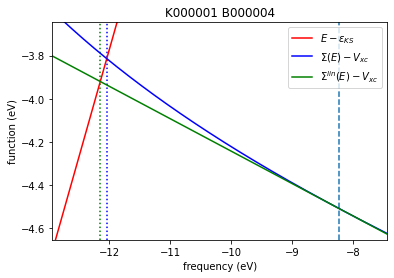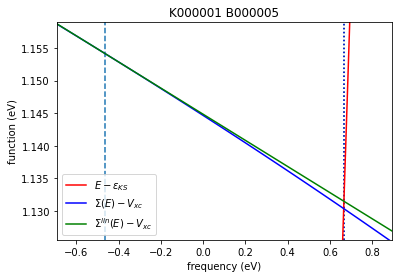This tutorial can be downloaded link.
2.0 Analyzing the frequency dependency in GW calculations¶
We analyze the frequency dependency of the GW self-energy, by exploring two ways of solving the Quasiparticle equation:
without linearization
\begin{align} E-\varepsilon_{KS} = \langle \Sigma(E) -V_{xc} \rangle \end{align}
with linearization (first-order expansion of self-energy in the frequency domain)
\begin{align} E-\varepsilon_{KS} = \langle \Sigma(\varepsilon_{KS}) -V_{xc} \rangle + (E-\varepsilon_{KS}) \langle \frac{\partial\Sigma}{\partial E}(\varepsilon_{KS}) \rangle \end{align}
where \(\varepsilon_{KS}\) is the Kohn-Sham energy, and \(E\) is the QP energy obtained at the \(G_0W_0\) level of theory.
After completing step 1 and step 2 of the 1.0 Tutorial, we download the following file:
[1]:
%%bash
wget -N -q http://www.west-code.org/doc/training/silane/wfreq_spec.in
Let’s inspect the wfreq_spec.in file, input for wfreq.x.
[1]:
%%bash
cat wfreq_spec.in
input_west:
qe_prefix: silane
west_prefix: silane
outdir: ./
wstat_control:
wstat_calculation: S
n_pdep_eigen: 50
wfreq_control:
wfreq_calculation: XWGQP
n_pdep_eigen_to_use: 50
qp_bandrange: [4,5]
n_refreq: 2000
ecut_refreq: 2.0
ecut_spectralf: [-1.5,0.5]
n_spectralf: 2000
Run wfreq.x on 2 cores.
[ ]:
%%bash
mpirun -n 2 wfreq.x < wfreq_spec.in > wfreq_spec.out
The output file wfreq.out contains information about the calculation of the GW self-energy, and the corrected electronic structure can be found in the file <west_prefix>.wfreq.save/wfreq.json.
Below we show how to load and plot the frequency-dependent quasiparticle corrections.
[3]:
import json
import numpy as np
# Load the output data
with open('silane.wfreq.save/wfreq.json') as json_file:
data = json.load(json_file)
# Extract converged quasiparticle (QP) corrections
k=1
kindex = f"K{k:06d}"
bandmap = data["output"]["Q"]["bandmap"]
eqp = data["output"]["Q"][kindex]
freqlist = np.array(data["output"]["P"]["freqlist"], dtype="f8")
spf = data["output"]["P"][kindex]
[10]:
# Plot
import matplotlib.pyplot as plt
for i, b in enumerate(bandmap) :
eks, eqpLin, eqpSec = eqp['eks'][i], eqp['eqpLin'][i], eqp['eqpSec'][i]
# Print QP corrections
print (f"{'k':^10} | {'band':^10} | {'eks [eV]':^15} | {'eqpLin [eV]':^15} | {'eqpSec [eV]':^15}")
print(77*"-")
print(f"{k:^10} | {b:^10} | {eks:^15.3f} | {eqpLin:^15.3f} | {eqpSec:^15.3f}")
sigmax, vxcl, vxcnl = eqp['sigmax'][i], eqp['vxcl'][i], eqp['vxcnl'][i]
sigmac_eks = eqp['sigmac_eks']['re'][i]
sigmac_eqpLin = eqp['sigmac_eqpLin']['re'][i]
sigmac_eqpSec = eqp['sigmac_eqpSec']['re'][i]
z = eqp['z'][i]
bindex = f"B{b:06d}"
sigmac = np.array(spf[bindex]['sigmac']['re'], dtype="f8")
# Left-hand side of QP equation
plt.plot(freqlist,freqlist-eks,'r-',label=r"$E-\varepsilon_{KS}$")
# Right-hand side of QP equation without linearization
plt.plot(freqlist,sigmac+sigmax-vxcl-vxcnl,'b-',label=r"$\Sigma(E)-V_{xc}$")
# Right-hand side of QP equation with linearization
plt.plot(freqlist,sigmac_eks+sigmax-vxcl-vxcnl+(1-1/z)*(freqlist-eks),'g-',label=r"$\Sigma^{lin}(E)-V_{xc}$")
plt.legend()
plt.title(kindex+" "+bindex)
plt.xlabel("frequency (eV)")
plt.ylabel("function (eV)")
xmin, xmax = min(eks, eqpLin, eqpSec), max(eks, eqpLin, eqpSec)
ymin, ymax = min(sigmac_eks, sigmac_eqpLin, sigmac_eqpSec), max(sigmac_eks, sigmac_eqpLin, sigmac_eqpSec)
ymin += sigmax - vxcl -vxcnl
ymax += sigmax - vxcl -vxcnl
plt.vlines(x=eks,ymin=ymin-0.2*(ymax-ymin),ymax=ymax+0.2*(ymax-ymin),ls="--")
plt.vlines(x=eqpLin,ymin=ymin-0.2*(ymax-ymin),ymax=ymax+0.2*(ymax-ymin),ls=":",color="g")
plt.vlines(x=eqpSec,ymin=ymin-0.2*(ymax-ymin),ymax=ymax+0.2*(ymax-ymin),ls=":",color="b")
plt.xlim([xmin-0.2*(xmax-xmin),xmax+0.2*(xmax-xmin)])
plt.ylim([ymin-0.2*(ymax-ymin),ymax+0.2*(ymax-ymin)])
plt.show()
k | band | eks [eV] | eqpLin [eV] | eqpSec [eV]
-----------------------------------------------------------------------------
1 | 4 | -8.230 | -12.150 | -12.044

k | band | eks [eV] | eqpLin [eV] | eqpSec [eV]
-----------------------------------------------------------------------------
1 | 5 | -0.466 | 0.666 | 0.665

We see that eqpLin (green dotted line) and eqpSec (blue dotted line) correspond to the solution of the Quasiparticle equation with and without linearization of the frequency dependency, respectively.
[ ]: